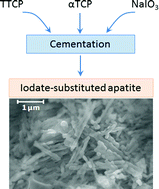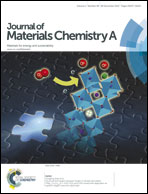Immobilization of iodine into a hydroxyapatite structure prepared by cementation†
Abstract
In order to manage radioactive iodine-129 coming from nuclear spent fuel, robust host matrices with durable long term behaviour need to be developed. In this work, a new process of synthesis of an iodate-substituted hydroxyapatite by means of a cementation route is described. This material was obtained from a mixture of tetracalcium phosphate (TTCP), tricalcium phosphate (αTCP) and sodium iodate (NaIO3), taken in a molar ratio of 1/2/0.5. The progress of the reaction leading to the setting and hardening of cement paste was monitored by combined measurements of electrical conductivity and heat flux release, together with XRD characterization of materials at definite times of hydration. Sodium iodate acts as a set retarder, by leading to the precipitation of non-cohesive transient phases, which are then destabilized when the massive precipitation of hydroxyapatite occurs. These delays can however be limited by adding hydroxyapatite seeds to the cement paste, which means that it is possible to control the setting time in view of an industrial application. This novel cementitious system leads to a porous material composed of iodine-substituted hydroxyapatite needles covering residual TTCP and αTCP particles. Iodine has entered the hydroxyapatite structure in the form of iodate anions only. An iodine incorporation rate of 6.5 wt% has been obtained by this cementitious system, which is a promising value in view of using these materials for the conditioning of radioactive iodine.


 Please wait while we load your content...
Please wait while we load your content...